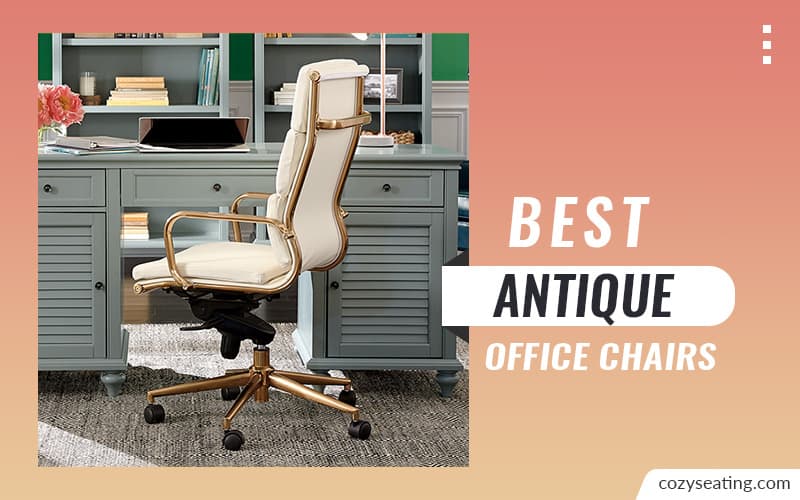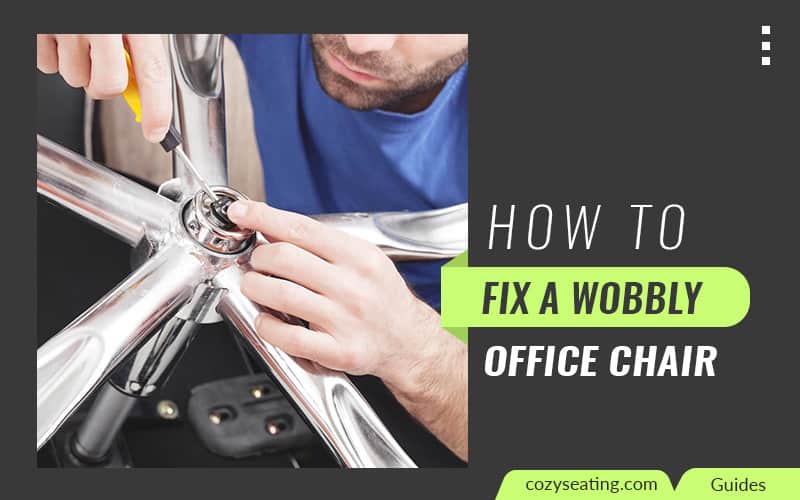
Disclosure: This site is reader-supported & contains affiliate links. We may earn a commission through products purchased using links on this page. Learn more

Going to work only to find your favorite office chair making a loud squealing sound is annoying. Fortunately, there are many things you can do to stop these sounds from happening again.
In this piece, I give you super easy solutions on how to fix squeaky office chair.
Your office chair is squeaky because some parts are loose, rusted, dirty, lost, or broken. Luckily, fixing is easy. You stop your office chair from squeaking by replacing lost and broken parts, tightening loose ones, and properly positioning them. You Fix a Squeaky Chair Spring by replacing it.
Table of Contents
Why Is My Office Chair So Squeaky?
Worn parts don’t always cause squeaky chairs. Sometimes, the problem lies within the design itself.
For example, many modern office chairs feature a “scoop” style seat cushion.
While this type of seating provides support, it doesn’t provide enough space for the body to sink comfortably into the seat. As a result, people tend to slump forward while seated, creating pressure points that lead to discomfort and even pain.
Other times, the problem stems from poor maintenance. Chairs left outside during inclement weather often develop mold growth due to moisture seeping under the fabric covering. Mold spores thrive in damp conditions, and once established, they can snowball.
Eventually, the mold produces toxins that irritate skin tissue, leading to rashes and other unpleasant sensations.
How Do I Stop My Office Chair from Squeaking?
Fixing a squeaky chair is easy once you understand the basic principles involved. The first step is always going to involve taking everything apart. Doing this allows you to inspect all parts thoroughly and determine what needs fixing.
After that, you’re ready to replace any damaged components and then reinstall everything correctly. It may seem like many steps, but if you follow each one carefully, you shouldn’t have much trouble getting your chair working smoothly again.
Here are the top ten tips to help keep your office chair from squeaking:
Make Sure Your Seats Are Level
First off, make sure that both sides of your chair are level so that the weight distribution is even across the bottom. If one side seems more raised than the other, try moving some items around until they feel balanced out.
Besides, doing this also prevents any uneven wear or damage to your seat.
Check for Loose Parts
Sometimes, after years of being used, the cushions inside our seats start to sag and lose shape. As a result, the padding doesn’t fit properly anymore. The load on the chair may also result in your casters becoming loose.
If you notice anything loose inside your chair, such as screws, bolts, and the like, tighten them down with an Allen wrench. You don’t want something falling into your lap while sitting at work.
Adjust the Height of Your Chair
One common reason why chairs begin to squeak is that the height setting is too high. If it’s set at an angle or the seat cushion has lost its original shape, try lowering the height until the noise stops.
Related:
Clean the Seat Cushion With a Brush or Vacuum
If all else fails, use a brush or vacuum cleaner to clean out any debris that may be causing the problem. Doing this also ensures that the fabric stays smooth and soft for more extended periods.
Use an Anti-Squeak Spray
An anti-squeak spray works by filling tiny holes with glue which prevents air from getting through them. When applied correctly, this should prevent future noises.
Replace Old Springs and Tensioners
Old springs and tensioners tend to break over time due to constant pressure and friction. Replacing old parts with new ones could save you money in the long run.
Try Using Different Types of Fabric for Your Seat Coverings
Different types of fabrics have different properties. Some materials hold their shape better than others. In addition, certain fabrics absorb moisture faster than others.
So, depending on the type of material you choose, you might get a quieter experience.
Learn more: How to Reupholster an Office Chair
Consider Adding Extra Support Underneath
Some people add extra support underneath their office chairs to reduce stress on the frame. While this won’t necessarily fix the issue altogether, it does provide a little bit of relief.
Add Rubber Feet to Your Desk
Rubber feet aren’t just great for keeping things steady; they also offer a good amount of shock absorption. In addition, they’ll protect your desk surface from scratches and dents caused by heavy objects resting on top of it.
Use Quality Foam Padding
For most people, the main component of a good quality chair is the padding itself. However, sometimes manufacturers put cheap foams inside their products.
While these types of foams work fine for cheaper models, they aren’t nearly as durable as higher-end ones. They tend to break down faster and eventually fall apart. Therefore, it’s essential to buy only top-notch foams whenever possible.
Maintenance
The most straightforward way to keep your office chair quiet is by maintenance. Most office chairs require regular cleaning and care to remain comfortable and durable. Cleaning involves wiping down the surface of the chair with soap and water after every use.
Also, ensure you clean the armrests too, especially if they contain leather. Leather tends to dry out very fast, leaving behind unsightly cracks and crevices.
Use a soft brush to scrub the surfaces free of dirt and grime gently. Don’t worry about getting the bristles dirty. Simply wipe them clean afterward.
If you suspect that your office chair contains hidden molds, consult a professional cleaner specializing in indoor environments. They can perform thorough inspections and identify potential sources of contamination.
How Do You Fix a Squeaky Chair Spring?
If you find yourself constantly hearing squeaks coming from your office chair, chances are one of the springs has gone bad. The most common culprits include metal fatigue and corrosion.
First, examine the coils themselves to determine what kind of damage you are dealing with. Are the coils cracked or bent? Do they appear rusty?
Is their color different from surrounding areas? These clues suggest that either corrosion or fatigue has taken place.
Corrosion
Corrosion happens when metals come into contact with oxygen and water. When exposed to air, iron rusts quickly; aluminum corrodes much slower but still eventually turns greenish-brown.
Both types of corrosion leave tiny pits in areas the metal gets damaged. Over time, these pits become more pronounced until the metal begins to crack.
Once the cracking reaches the point where the metal breaks apart wholly, the piece becomes useless. Therefore, you must remove corroded pieces immediately.
Fatigue
Fatigue happens when repeated stress causes small holes to form inside the coil. Because the hole grows slowly, it takes longer for the metal to break. Nevertheless, the result remains the same: A weakened part no longer performs properly.
The best way to prevent corrosion is to keep the area well ventilated. Remove anything that could trap moisture, including carpeting, furniture pads, and upholstery fabrics.
Also, remove any objects that would otherwise attract moisture, like plants. You can also protect against corrosion using products designed specifically for the purpose.
Some manufacturers sell anti-corrosion sprays that coat the affected area with a protective layer. Others recommend applying a clear sealant to the spot. Either approach works just fine.
The next step depends on how badly the damage to the metal is.
If only a few strands of wire are broken, simply replace them.
Otherwise, cut out the defective section and use pliers to pull off the rest of the old material. Then carefully file down the remaining rough spots so that new coils fit snugly. Afterward, apply a thin coating of lubricating oil to help ensure proper seating.
To avoid buying a whole new set of springs, consider buying replacement parts online instead.
Frequently Asked Questions
What Can I Spray on Squeaky Office Chair?
You can spray WD40 on a squeaky office chair to temporarily stop the noise. However, WD40 doesn’t work too effectively on dry surfaces. So, it may not stop your chair from squeaking entirely. And it won’t fix a loose screw. Even so, WD40 does have some other benefits.
First, it’s inexpensive. Second, it’s easy to clean up after application. The lubricant is also pretty good at its job.
Is Creaking Furniture Normal?
Creaking furniture is not normal, and it indicates problems in the structure of the chair.
In many cases, this means that the seat cushion needs replacing. But if the problem persists even after removing the cushions, then there might be something else wrong.
For example, an improperly installed hinge could cause the entire mechanism to disfunction. Or perhaps the frame isn’t strong enough to support the weight of the person sitting on top of it.
Conclusion
Solving the squeak in an office chair calls for patience and diligence. Fortunately, fixing this type of problem doesn’t require special tools or skills.
All you need is a little bit of knowledge about how office chairs work. With that information at hand, you should be able to get rid of those annoying squeaks once and for all.
Recommended Reading

10 Best Antique Office Chair in 2022
Antique office chairs are a great way to add a touch of class to your home or office. Here's how to find the best antique office chair for yourself!

How to Fix a Sinking Office Chair by Following These Quick Ways
Is your office chair sinking? Find out what you can do to make your chair feel brand new. Discover how to fix a sinking office chair.

How to Adjust Office Chair Seat Angle
Most people don't know how to set up their office chairs correctly. Our article explains how to adjust the seat angle of an office chair.

How to Fix a Wobbly Office Chair in Easy Steps
Does your office or home have a wobbly chair? Check out this quick guide on how to fix a wobbly office chair and keep it stable again!
